 |
| August 07, 2012 | Volume 08 Issue 29 |
Designfax weekly eMagazine
Archives
Partners
Manufacturing Center
Product Spotlight
Modern Applications News
Metalworking Ideas For
Today's Job Shops
Tooling and Production
Strategies for large
metalworking plants
Kayak slalom presents Olympic engineering challenge
Creaform and Geomagic come to the aid of Australia's kayak team
By Brett Duesing
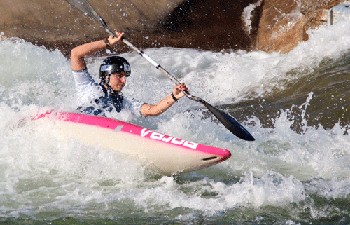
Olympic Kayaker Jessica Fox in action.
Olympic sport keeps pushing athletes to find new and nuanced ways to condition their bodies. The same is true with their equipment. Engineers continually look for new refinements that propel the competition to a new level.
Much of this latter challenge lies in the realm of biomechanics, or movement science. Ami Drory is biomechanist at the Australian Institute of Sport.
One of his new developments for the 2012 summer games in London was to find a better "fitout" of kayakers in the canoe slalom.
Fitout means building custom parts of foam and wood for the seat of the craft.
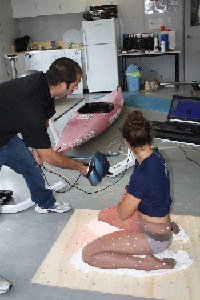
Scanning with the Creaform REVscan to get the lower body shape of Jessica.
It sounds like a simple matter of measurement and cushioning, but in the slalom, fitout gives the competitors an especially crucial edge. In the event, paddlers have to maneuver through 18 to 25 gates as fast as possible. The tough parts are the segments that are upstream. To propel against the whitewater, the paddle, kayaker, and canoe have to act together as one.
"The transfer forces applied through the paddle are a primary determinant of success," explains Drory. "A good fitout allows the athlete to use their full range of motion while transferring as much force as possible into the water."
Automated measurements for better fit
Past methods of fitout have been laborious, and the results are not easily repeatable. "There can be a frustrating process of trial and error and wasted material before you get it right," Drury says.
Tasked with about a dozen customizations in a limited time window, he decided to explore an automated process for fitout. His goal was to develop a reliable and repeatable series of digital procedures that would start with real forms of boat and athlete and end with manufactured parts.
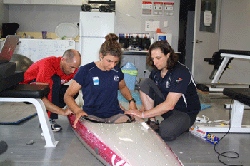
Scanning both the athlete and kayak.
The first step was to accurately scan the athlete in position. AIS owned its own 3D laser scanner for use on other sports equipment design, but Drury says the device was insufficient for the project because of the amount of detailed surfacing required in each customization. To handle such a large set of geometric data, he enlisted the help of a Canadian, Sebastien Dubois, an application specialist from the Quebec City-based scanner developer Creaform.
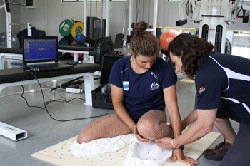
Creating a clay mold that will also be scanned for greater accuracy.
Dubois brought one of Creaform's portable handheld laser scanners, the REVscan, to the AIS facility in Brane. The REVscan is a lightweight handheld 3D scanner weighing just 2.1 lb, with a resolution of 0.004 in. and an accuracy of 0.05 in. Used at a standoff distance of up to 12 in., this is an ideal scanner for accurate, close-in work. It is perfect for organic shapes such as human bodies, and generates industrial-level accuracy results.
Scanning kayaker Jessica Fox in position wearing a webbing of point markers, Dubois and Drory created the initial digital test model. The scanning equipment, featuring TRUaccuracy technology (which ensures highly accurate measurements, regardless of the environment), mapped 3,500,000 polygons-worth of 3D points in about an hour. Another thorough two-hour scan captured the interior of Fox's competition kayak.
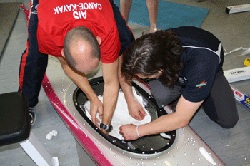
Creating a clay impression of the inside of the kayak for scanning into 3D.
Using Creaform's VXelements software, Dubois produced STL polygonal data files of the scans that were imported into Geomagic Studio, a product that is ideal for fast, automated processing of almost every kind of 3D data into precise NURBs surfaces for use in CAD. Both Fox's body scan and the kayak scan were processed through Geomagic's system, where they could be saved as IGES data for import into SolidWorks.
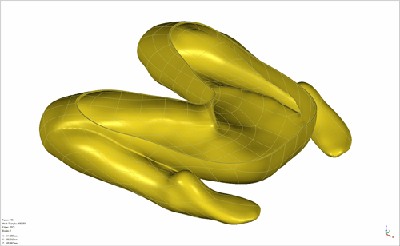
3D NURBs model of the athlete ready to be used in CAD engineering processes.
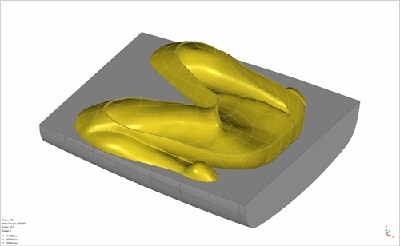
The athlete's scan and the kayak model together.
Once in the CAD system, Boolean operations on the data could be used to enable precise modeling of the kayak fitout, customized perfectly to the athlete's unique body shape. Using this process, Dubois scanned and processed 11 athletes' scans in three days.
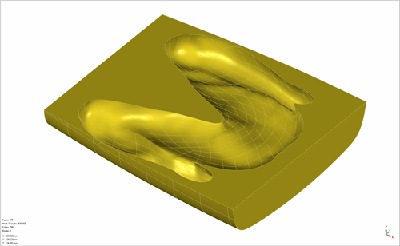
The design required for the fitout customized to the athlete's unique shape, created using Boolean operations in SolidWorks from the Geomagic models.
Changing what is possible
Stephane Auclair, vice president of marketing at Creaform, comments on the success of the project: "The Olympics is always a place where barriers and limits are meant to be broken. This is the sort of project which really illustrates how 3D scanning advancements are changing what is possible. More and more, we are seeing how objects can be made to conform to fit unique body shapes very quickly, and as a result creating products that become a comfortable extension of ourselves."
Will this engineering give Australia the edge to bring home a medal in the canoe slalom? We'll have to watch and see. Medal or not, Drory is confident that the improvements in fit will at the very least shave some time off the clock, giving the athlete's a better chance to achieve their best times.
UPDATE: On Aug. 2, Jessica Fox won a silver medal in Women's Kayak (K1), so things are looking good for team Australia so far. Events are being held at the Lee Valley White Water Centre, located 30 km north of the Olympic Park in East London, on the edge of the 1,000-acre River Lee Country Park.
"This project was a fast and efficient workflow from measurement to manufacturing that is individualized for each athlete," says Drory. "The optimal boat fitout for each athlete may have a significant positive impact on the performance and success of those athletes in the 2012 London Olympics."
About AIS
The Australian Institute of Sport (AIS) is Australia's national high-performance sport institution, internationally acknowledged as a world's best practice model for high-performance in sport.
About Creaform
Creaform develops, manufactures, and sells 3D portable measurement technologies and specializes in 3D engineering services. The company offers innovative solutions that cover the entire range of 3D applications, including 3D scanning, reverse engineering, quality control, non-destructive testing, product development and simulation.
About Geomagic
Geomagic software delivers a significant positive impact on the world using 3D design, engineering, manufacturing, and QA operations for greater productivity, product time to market, and efficiency in every process.
Published August 2012
Rate this article
View our terms of use and privacy policy
